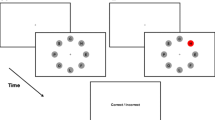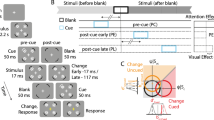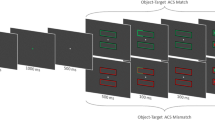Abstract
According to the contingent involuntary orienting hypothesis, only stimuli that match the attentional control settings based on intentions capture attention. In contrast, the surprise-capture hypothesis states that expectancy-discrepant stimuli can capture attention even if they do not match the control settings, implying unintended capture. The purpose of this study is to investigate whether unintended and intended attentional shifts are characterized by different time courses, indicating different underlying mechanisms. An unintended attentional shift was tested by the first, unannounced presentation of a color singleton at the location of a visual search target, and intended shifts by the following repeated presentations of a predictive singleton. Differences in time course were revealed by varying the stimulus onset asynchrony (SOA) between singleton and target. Results showed that accuracy with expected singletons was barely affected by SOA, whereas SOA strongly affected accuracy with the unexpected singleton. The results are interpreted as supporting the surprise-capture hypothesis. It is furthermore argued that a division of labor between contingent capture and surprise in the control of attention supports adaptive behavior.



Similar content being viewed by others
Notes
It should be emphasized that it is not supposed that the attentional shift is caused by the feeling of surprise. Instead, surprise is conceived of as a syndrome of responses to unexpected (schema-discrepant) events, with one of the components of this syndrome being the attentional shift.
To what extent this is possible remains to be examined. A good guess, however, appears to be that only basic features, but not their conjunctions, capture attention in the way examined in the present experiments (cf. Treisman & Gelade, 1980).
References
Ansorge, U. & Heumann, M. (2003). Top-down contingencies in peripheral cuing: The roles of color and location. Journal of Experimental Psychology: Human Perception and Performance, 29, 937–948.
Bacon, W. F., & Egeth, H. (1994). Overriding stimulus-driven attentional capture. Perception & Psychophysics, 55, 485–496.
Bargh, J. A. (1989). Conditional automaticity: Varieties of automatic influence in social perception and cognition. In J. S. Uleman & J. A. Bargh, Unintended Thought (pp. 3–51). New York: Guilford.
Chastain, G., & Cheal, M. L. (1998). Automatic versus directed attention with single-element and multiple-element precues. Visual Cognition, 5, 339–364.
Cheal, M. L., & Chastain, G. (1998). Attention effects of moving and stationary single-element and multiple-element precues: Limits of automaticity. Perception & Psychophysics, 60, 873–887.
Desai, M. M. (1939). Surprise: A historical and experimental study. British Journal of Psychology: Monograph Supplements, 22.
Di Lollo, V., Enns, J. T., & Rensink, R. A. (2000). Competition for consciousness among visual events: The psychophysics of reentrant visual processes. Journal of Experimental Psychology: General, 129, 481–507.
Enns, J. T., Austen, E. L., Di Lollo, V., Rauschenberger, R., & Yantis, S. (2001). New objects dominate luminance transients in setting attentional priority. Journal of Experimental Psychology: Human Perception & Performance, 27, 1287–1302.
Folk, C. L., & Remington, R. (1998). Selectivity in distraction by irrelevant featural singletons: Evidence for two forms of attentional capture. Journal of Experimental Psychology: Human Perception & Performance, 24, 847–858.
Folk, C. L., Remington, R. W., Johnston, J. C. (1992). Involuntary covert orienting is contingent on attentional control settings. Journal of Experimental Psychology: Human Perception and Performance, 18, 1030–1044.
Folk, C. L., Remington, R. W., Johnston, J. C. (1993). Contingent attentional capture: A reply to Yantis (1993). Journal of Experimental Psychology: Human Perception and Performance, 19, 682–685.
Folk, C. L., Remington, R. W., & Wright, J. H. (1994). The structure of attentional control: Contingent attentional capture by apparent motion, abrupt onset, and color. Journal of Experimental Psychology: Human Perception & Performance, 20, 317–329.
Gibson, B. S., & Jiang, Y. (1998). Surprise! An unexpected colour singleton does not capture attention in visual search. Psychological Science, 9, 176–182.
Gibson, B. S., & Kelsey, E. M. (1998). Stimulus-driven attentional capture is contingent on attentional set for display-wide visual features. Journal of Experimental Psychology: Human Perception and Performance, 24, 699–706.
Horstmann, G. (2002). Evidence for attentional capture by a surprising colour singleton in visual search. Psychological Science, 13, 499–505.
Horstmann, G. (2004). Attentional capture by a surprising colour singleton depends on its expectancy discrepancy. Manuscript submitted for publication.
Jonides, J. (1981). Voluntary versus automatic control over the mind’s eye movement. In J. Long & A. D. Baddeley (Eds.), Attention & Performance IX (pp. 187–203). Hillsdale, NJ: Erlbaum.
Jonides, J., & Yantis, S. (1988). Uniqueness of abrupt visual onset in capturing attention. Perception & Psychophysics, 43, 346–354.
Kim, M. & Cave, K. R. (1999). Top-down and bottom-up attentional control: On the nature of interference from a salient distractor. Perception & Psychophysics, 61, 1009–1023.
Mack, A., & Rock, I. (1998). Inattentional blindness. Cambridge, MA: MIT Press.
Meyer, W.-U. (1988). Die Rolle von Überraschung im Attributionsprozeß. Psychologische Rundschau, 39, 136–147.
Meyer, W.-U., Niepel, M. (1994). Surprise. In V. S. Ramachandran (Ed.), Encyclopedia of human behavior (Vol. 4, pp. 353–358). Orlando, FL: Academic.
Meyer, W.-U., Niepel, M., Rudolph, U., & Schützwohl, A. (1991). An experimental analysis of surprise. Cognition and Emotion, 5, 295–311.
Meyer, W.-U., Reisenzein, R., & Schützwohl, A. (1997). Toward a process analysis of emotions: The case of surprise. Motivation and Emotion, 21, 251–274.
Most, S. B., & Simons, D. J. (2001). Attention capture, orienting, and awareness. In C. Folk & B. Gibson (Eds.), Attraction, distraction, and action: Multiple perspectives on attentional capture (pp. 151–173). Amsterdam: Elsevier.
Most, S. B., Simons, D. J., Scholl, B. J., Jimenez, R., Clifford, E., & Chabris, C. F. (2001). How not to be seen: The contribution of similarity and selective ignoring to sustained inattentional blindness. Psychological Science, 12, 9–17.
Neisser, U. (1976). Cognition and reality: Principles and implications of cognitive psychology. San Francisco: Freeman.
Neisser, U. (1979). The control of information pickup in selective looking. In A. D. Pick (Ed.), Perception and its development: A tribute to Eleanor J. Gibson (pp. 201–219). Hillsdale, NJ: Erlbaum.
Neumann, O. (1984). Automatic processing: A review of recent findings and a plea for an old theory. In W. Prinz & A. F. Sanders, Cognition and Motor Processes (pp. 255–293). Berlin Heidelberg New York: Springer.
Niepel, M., Rudolph, U., Schützwohl, A. & Meyer, W.-U. (1994). Temporal characteristics of the surprise reaction induced by schema-discrepant visual and auditory events. Cognition and Emotion, 8, 433–452.
Nothdurft, H.-C. (2000). Salience from feature contrast: Variations with texture density. Vision Research, 40, 3181–3200.
Posner, M. I. & Snyder, C. R. R. (1975). Attention and cognitive control. In R. L. Solso (Ed.), Information processing and cognition: The Loyola Symposium (pp. 55–82). Hillsdale, NJ: Erlbaum.
Prinz, W. (1983). Wahrnehmung und Handlungssteuerung. Berlin Heidelberg New York: Springer.
Prinz, W. (1990). Unwillkürliche Aufmerksamkeit. In C. Meinecke & L. Kehrer (Eds.), Bielefelder Beiträge zur Kognitionspsychologie (pp. 49–57). Göttingen, Germany: Hogrefe.
Rauschenberger, R. (2003). When something old becomes something new: Spatiotemporal object continuity and attentional capture. Journal of Experimental Psychology: Human Perception and Performance, 29, 600–615.
Rumelhart, D. E. (1984). Schemata and the cognitive system. In R. S. Wyer & T. K. Srull (Eds.), Handbook of social cognition (Vol. 1, pp. 161–188). Hillsdale, NJ: Erlbaum.
Schützwohl, A. (1998). Surprise and schema strength. Journal of Experimental Psychology: Learning, Memory, and Cognition, 24, 1182–1199.
Selz, O. (1922). Zur Psychologie des produktiven Denkens und des Irrtums : eine experimentelle Untersuchung. Bonn, Germany: Cohen.
Simons, D. J. (2000). Attentional capture and inattentional blindness. Trends in Cognitive Sciences, 4, 147–155.
Simons, D. J, & Chabris, C. F. (1999). Gorillas in our midst: Sustained inattentional blindness for dynamic events. Perception, 28, 1059–1074.
Theeuwes, J. (1992). Perceptual selectivity for color and form. Perception & Psychophysics, 51, 599–606.
Theeuwes, J. (1994). Stimulus-driven capture and attentional set: Selective search for color and visual abrupt onsets. Journal of Experimental Psychology: Human Perception and Performance, 20, 799–806.
Theeuwes, J., Burger, R. (1998). Attentional control during visual search: The effect of irrelevant singletons. Journal of Experimental Psychology: Human Perception & Performance, 24, 1342–1353.
Theeuwes, J. & Godijn, R. (2001). Attentional and oculomotor capture. In Folk, C. L. & Gibson, B. S. (Eds.), Attraction, distraction and action: Multiple perspectives on attentional capture (pp. 121–149). Amsterdam: Elsevier.
Theeuwes, J., Kramer, A. F., Hahn, S., & Irwin, D. E. (1998). Our eyes do not always go where we want them to go: Capture of the eyes by new objects. Psychological Science, 9, 379–385.
Treisman, A. M., & Gelade, G. (1980). A feature-integration theory of attention. Cognitive Psychology, 12, 97–136.
Wilcocks, R.-W. (1928). The effect of an unexpected heterogeneity on attention. Journal of General Psychology, 1, 286–319.
Wolfe, J. M. (1994). Guided search 2.0: A revised model of visual search. Psychonomic Bulletin & Review, 1, 202–238.
Yantis, S. (1993). Stimulus-driven attentional capture and attentional control settings. Journal of Experimental Psychology: Human Perception and Performance, 19, 676–681.
Yantis, S., & Egeth, H. E. (1999). On the distinction between visual salience and stimulus-driven attentional capture. Journal of Experimental Psychology: Human Perception and Performance, 25, 661–676.
Yantis, S., & Hillstrom, A. P. (1994). Stimulus-driven attentional capture: Evidence from equiluminant visual objects. Journal of Experimental Psychology: Human Perception and Performance, 20, 95–107.
Yantis, S., & Jonides, J. (1984). Abrupt visual onsets and selective attention: Evidence from visual search. Journal of Experimental Psychology: Human Perception and Performance, 10, 601–621.
Acknowledgements
This research was supported by a grant from the Deutsche Forschungsgemeinschaft (ME 708/4–1) to Wulf-Uwe Meyer. I am indebted to Sabine Dlugosch for conducting the experiments, to Lily-Maria Silny for her technical assistance in manuscript preparation, and to Elena Carbone, Asher Cohen, Manfred Heumann, Wulf-Uwe Meyer, Ingrid Scharlau, Jan Theeuwes, and an anonymous reviewer for their helpful comments on earlier versions of the manuscript.
Author information
Authors and Affiliations
Corresponding author
Rights and permissions
About this article
Cite this article
Horstmann, G. The time course of intended and unintended allocation of attention. Psychological Research 70, 13–25 (2006). https://doi.org/10.1007/s00426-004-0184-7
Received:
Accepted:
Published:
Issue Date:
DOI: https://doi.org/10.1007/s00426-004-0184-7




